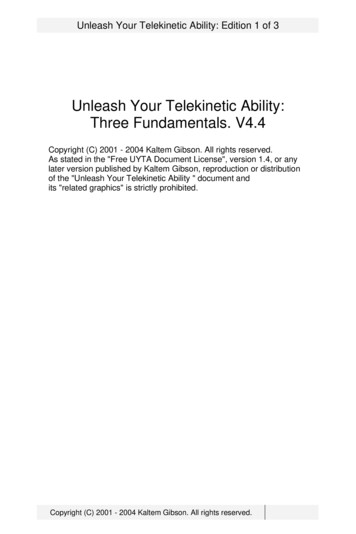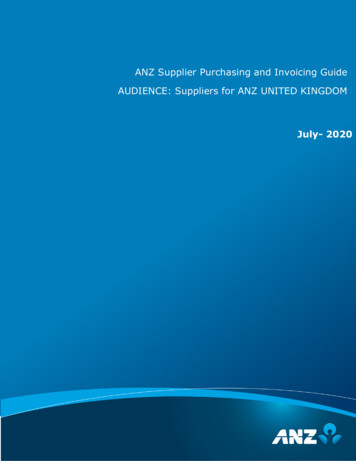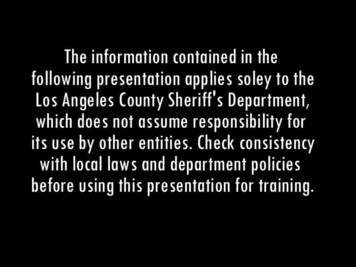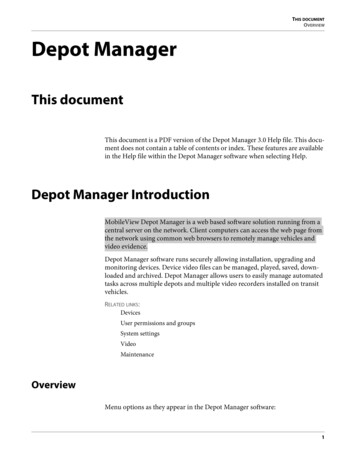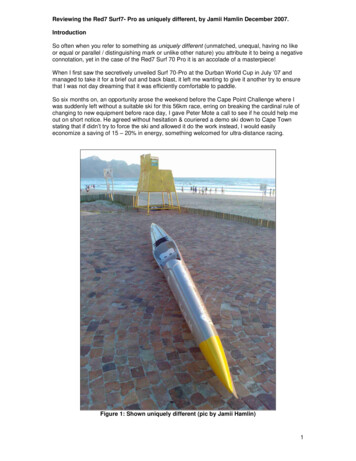
Transcription
Reviewing the Red7 Surf7- Pro as uniquely different, by Jamii Hamlin December 2007.IntroductionSo often when you refer to something as uniquely different (unmatched, unequal, having no likeor equal or parallel / distinguishing mark or unlike other nature) you attribute it to being a negativeconnotation, yet in the case of the Red7 Surf 70 Pro it is an accolade of a masterpiece!When I first saw the secretively unveiled Surf 70-Pro at the Durban World Cup in July ‟07 andmanaged to take it for a brief out and back blast, it left me wanting to give it another try to ensurethat I was not day dreaming that it was efficiently comfortable to paddle.So six months on, an opportunity arose the weekend before the Cape Point Challenge where Iwas suddenly left without a suitable ski for this 56km race, erring on breaking the cardinal rule ofchanging to new equipment before race day, I gave Peter Mote a call to see if he could help meout on short notice. He agreed without hesitation & couriered a demo ski down to Cape Townstating that if didn‟t try to force the ski and allowed it do the work instead, I would easilyeconomize a saving of 15 – 20% in energy, something welcomed for ultra-distance racing.Figure 1: Shown uniquely different (pic by Jamii Hamlin)1
Concept overview.What is distinguishing about the Surf 70- Pro is the attention to detail and the integrated designapplication of using CAD (computer aided design) technology to fully understand the likely hullspeed & hydrodynamic flow characteristics, aiding paddler ergonomics and efficient use ofmaterial lay-up in utilization weight distributions even before Red7 prototyped one for a water test!The skis concept was refined intelligently over a 6-month period to produce a no-bullshit productthat would equally guarantee a sound lightweight construction, ensuring safety and provide apaddler with a stable and fast ski for hours of quality enjoyment.Figure 2: Bow view with reinforcing rib blended into wave deflector (pic by Jamii Hamlin)Aesthetics & ConstructionOn first glance you‟ll notice the refined Surf 70-Pro has an almost torpedo shaped appeal similarto that of a stealth space rocket having 3 scupper drains that adds a highly effective sci-fi detail.With its slightly fuller volumed nose and a slender tail fashioned with a slightly whimsical split line& subtly reinforced deck styling suggesting it is uniquely different from any other ski you arefamiliar with and it is!On closer inspection you all appreciate the nose is prominently bulbous for downwind buoyancyyet efficiently narrowed to allow for most advantageous blade placement with the tail volumeabove the waterline has been optimally whittled away to reduced windage and material content,but the well rounded deck rails and ribbed deck construction allow for astute reinforcementwithout added material weight.Credible to Red7 growing reputation of pioneering innovation & pushing the technology envelop,is the astounding fact that this ski is manufactured as a single piece molding with the supportingstringer reduced to only beneath the seat area, void of traditional construction methods wheremost other manufacturers rely upon the stringer and diagonal cross support as the structuralbackbone with a skin cladding.Adding to this Red7 have revolutionized a new ski construction technology of using a VacuumInfusion Processes (VIP) with strategically place carbon and kevlar strengthening braces to2
create an impressively hard and rigid construction which incorporated the strengthening aid of thecurved split line to enhances the skins structural integrity.Figure 3: Side view (pic by Jamii Hamlin)Rocker and hull shapeNoticeably, the rocker is seemingly dead flat for the entire length of the ski except for a slightly upturned nose entry rocker that deepens and tapers out on the plan shape towards the hip area withthe flat planning hull section introduced & fading out a quarter length from the nose and tail.The nose entry is not overly foiled giving a reasonably sharp edge to cut into the water, but hasallowed sufficient bluntness to ensure it is sturdy to take heavy knocks without chipping and has abroaden waterline template in the nose to aid volume and improve stability as the flatten hullshape become very noticeable along the length reaching roughly 15-20cm (6-8”) flat beneath theseat as it tapers to an elegant tail.Contrary to the trend of fuller & slightly wider tail volumes Red7 has been highly considerate toavoid this so to ensure that the paddler does not have a sudden tail surges that can broach orforce you off a subtle track.Using the hydrodynamic modeling this ski is design for fast & economical planning where theemphases is to allow the paddler to reduce his effort to gain a maximum return as the ski carriesthe workload for an efficient glide.3
Figure 4: Hull (pic by Jamii Hamlin)Weight & balanceThis demo glass ski weighted in at 15,5kg, yet with nominal longitudinal flex it is impressively ashard & rigid as a full carbon construction! Yet it would be expected that a full carbon ski wouldreduce the weight to -10kgs and carry a realistic price tag that some of us would be well justifiedin spending.However, without the lightweight advantages of carbon construction this demo ski is competitivelylightweight, being exceptionally stiff & impressively responsive in characteristics to feel like it wasmade of exotic materials. Thus the ski is perfectly poised with a feeling of cantilevered equalnessalong the tail or nose giving a lively and assertive balanced feel in paddling.Figure 5: Tail view with self draining rudder cover (pic Jamii Hamlin)4
Basic dimensionsLengthWidthBow heightSeat widthCatch widthCatch gunnels heightSeat gunnels heightSeat heightLeg length trackMetric: 6.6m: 0.42m: 0.36m: 0.39m: 0.31m: 0.24m: 0.22m: 30mm: 0.9 – 5”9,7” 1”35,5-47”Seating ergonomicsSeveral things are note worthy in the seating cockpit, yet the narrow catch area and very low seathigh are the most significant in making the paddler very comfortable with the bridge “beneath theknee” area being relatively low, allowing you to readily straighten your leg and feel similar to acanoe stroke set up.The leg length and footwell area is generous with ample width for larger feet having a positivelyangled footrest & peddle cluster with a sturdy and neoprene padded pull strap to ensure for hoursof comfort. There was some nominal flex in the footplate engaging onto the footwell floor, butusing a hard rubber strip beneath this would provide a temporary wedge or a blob of epoxy for amore permanent solution.Personally for myself not having the broadest of shoulders or the longest legs, I found the narrowcatch area combined well with the flatten knee-bridge seat and allowed me to improve my stroketo fully benefit from a more precise placement so to maximize my hip /leg extension in making thestroke rotation with greater power and shorten pull that removed the feeling of paddling with watermelon spaces beneath my arms!Figure 6: cockpit view (pic by Jamii Hamlin)5
Steering and handlingThe Surf 70-Pro is very easy to paddle, with a stable glide it reaches top speed very quickly andcruises so efficiently that one forgets that you are putting any effort in to propel it forward.As the ski is designed with a very flat rocker for a fast & economical paddle, it‟s immediatelynoticeable by the lateral steadiness in the lack of roll or sway across the hull when reachingforward in rapid sprint rotations.With a slightly forward steering box it has a very assertive and agile turning ability for a livelyresponse, yet whilst it has a positive feel one can not force the ski, so instead one changes focus& effort into using the longitudinal efficiency of the hull to maintain good speed and pick the bestline.The bulbous nose is great in punching through surf & popping back up after being submergedown a wave or run and the projected travel you maintain after a good surge is impressive inensuring a low cadence stroke & high speed which aids effort in control or linking runs.Whilst I haven‟t experience the ski in really big downwind conditions, I would be confident to thinkit would excel in wooly seas, as the reduced tail volume above the waterline ensures thatrefracting chop does not make it unpredictable in pitching the tail around as I found it extremelymanageable in riding broken surf.What is impressive is the rigid & solid construction for handling powerful surf, I found it very easyto control in taking big hits!The narrow gunnels did mean that I got splashed occasionally more that I was used too, howeverthe three x 20mm (0,75”) scuppers ensured that any water that slopped over the high gunnelsdrained away immediately.In punching through surf the tail didn‟t sink away backwards & the nose push easily over foamieswith little water rushing in over the high arched bow and built-in wave deflector that quickly shedthe carpet of water off. Even having been entirely swapped with waves landing squarely onto me Iwas able to get the ski up to speed and well drained before the next impact.Featuring star detailsThe 3 sci-fi scuppers look novel yet work incredible well in draining the ski quickly and oncedrained they gurgle with an anticipation of a jet engine readying for take off.Figure 7: Scuppers (Pic by Jamii Hamlin)6
Critical to any paddler‟s pedigree or in-experience is the ease in which one can remount their ski.Here the Surf70-Pro have excelled admirably by the well configured stern combination of thegentle soften rails and marginally lowered deck to ensure for an assessable straddle over therelatively low seat gunnels making for a quick & comfortable remount.Figure 8: Stern with bungi pad & seat (pic by Jamii Hamlin)Safety & reliability to me if always the higher priority that saving a few grams of weight and theSurf70-Pro with its 9,5mm (0,37”) stainless steel shaft is fasten by a 17mm(0,67”) „Locktite‟ nutthat secures the laser cut stainless steel yoke with an idiot proof system unlikely ever to fall off!A self draining cover encloses the steering rigging and allows be easily washing and partiallyinspected for early signs of disrepair. Underneath a slight bump molded into the hull provides awell integrated weed deflector in front of the rudder that pinches the gap between the hull andrudder closed, yet still allows for a free and uninhibited turning.Figure 9: Tail detail pic by Jamii Hamlin7
With a stainless steel cable running through the ski and thick nylon cord for tying the peddlesetting the push plate is easy to adjustment and reduces turning stretch, with a reinforcing ribrunning along most the length of the footwell endorses the thoughtfulness and attention to detailRed7 have gone to set themselves apart.Figure 10: Footwell (pic by Jamii Hamlin)Great finishing touches are the elastic bungi chord lacing with a smart backing EVA traction padon the stern & bow bridge upright for stowing or securing juice bags, PDFs, flare etc and a verysturdy & accessible handle on the left bridge for sprinting the ski up the beach or for remounting.Figure 11: (Cockpit gunnels pic by Jamii Hamlin)The litmus test, paddling the CPC8
Having only paddled a Surf70-Pro twice before, I received this one with only two days leeway toset up and familiarize myself with it before the 5:20 am departure for the 56km Cape PointChallenge in predicted conditions of a small 2.5m SE swell running with a 5-10 knot SSE headwind for the initial 30km trek, with the 3km bumpy section of haystack size waves refracting of thecliffs between Cape Maclear and the Cape Point tip with the remaining 26km sheltered in a dyingbreeze for a flat slog with hardly a bump to push you home!In preparation, I made three additions to the ski to assure that I would be 100% comfortable forthe expected 5 hours of paddling by inserting my own designed seat pad, added a 28x100mmslither to increase the base of the trailing edge of the rudder and glued on a pronounced “kelpcutter” as we very bound to be cutting a tight line through the jam-packed kelp beds.Despite a hiccup at the start where I struck a rock with my rudder & stopped to reset my bladefeathering & then set of to paddled at TT pace to catch up, our batch progressed conservativelyat 10.5kph until we got caught in the congested kelp beds off Bobbejans Point with a bump andsurge affair testing the rudders strength as we clawed our way though the congestion.For the 2 ¾ hour stretch to the midway turning point into the head wind and slightly bumpy openocean, I was super relaxed and wished that we could pushed a little faster as I felt like I wasoverly conserving myself with the skis efficiency.Crossing the confused section between Cape Maclear to the point itself, I picked up pace andnever missed as stroke through the refracted cross chop waves and quickly dropped my batch inthe tricky bumpiness.Rounding Cape Point into the calmness of False Bay right beneath Penguin Lighthouse 78mabove sea level, the elapsed start elite batch of Peter Cole, The Big O, Daryl Bartho, JasperMocke, Paul Marais & Ian Trautmann came racing past working hard to catch every run refractingaround & bouncing off the cliffs on towards Buffels Bay, where halfway along the 6 km stretchSteve Farrel & Dawid Mocke slipped by on the outside as the front elite leader group made about3-4 minute on me to the compulsory stop.From there the remaining 22 km to Fish Hoek was a flat water grind with an occasional run togive me a push every 5-10 minutes as I managed to raise my speed to average 12kph.Completing a long race like this always saps you energy towards the end, yet with the 3 monthsof preparation training, I felt as if the Surf70-Pro efficiency made it easier to keep pushing on thehome leg.On finishing I felt as thou I had enough reserves for another 20 km and was overly impressed bythe comfort & economical ease at which the Surf70-Pro glided along, I had an awesome paddlendfinishing 32 in a time of 5h07 or a percentage finish of 85,5% with my only regret was that Ihadn‟t migrated to a Surf70-Pro earlier in the season & feel this ski would be my ski of choice forrddoing my 3 244km PE-EL Challenge in December 2008.9
Figure 12: Jamii paddling into Buffels (Pic by Actionography)Glass Fiber Butt PadThe glass fiber butt pad skin comes from my Performer Canoe Seat, that received a SABS Design Institute of South Africa design accredited in 2004, designed to help relief dead leg ornumb bum by eliminating the pinching of the Sciatic nerve beneath the Ischium Bone, and uses aVelcro with foam backing to adjust & fit it snuggly into the seat well. The butt pad also increasesmy seat position by 15-20mm to improve my pelvic bone tilt & ensures a slightly more uprightposture allowing the low lumber vertebra to straighten for better reach and rotation.Rudder ModificationThe subtle refinement to the fin was more a precaution to dampen the agile turning ability of thefairly upright high aspect rudder and offset for any instability for the higher seating position.However the longer rudder base gives it a slightly more positive feel by providing better drive inholding a turn & also allowed me to use less rudder in steering the ski straight when paddling atpace. Adding my kelp cutter was probably unnecessary as the built in one is well incorporated butmore as a habit of poor experiences I glued on my own as insurance.10
Figure 13: Rudder (pic by Jamii Hamlin)Jamii Hamlin - bioJamii Hamlin is a qualified product designer for nearly 20 years and consults part-time for severalSouth African manufacturers looking to add value and innovation to their brands & exportproducts.He has received numerous design awards & accreditation for his own inventions andentrepreneurial endeavors for his blossoming venture which carries 3 International PCT‟s & adesign registration for an Agricultural Trellising & Fencing System manufactured of stainlesssteel.11
1 Reviewing the Red7 Surf7- Pro as uniquely different, by Jamii Hamlin December 2007. Introduction So often when you refer to something as uniquely different (unmatched, unequal, having no like or equal or parallel / distinguishing mark or unlike other nature) you attribute it to being a negative
